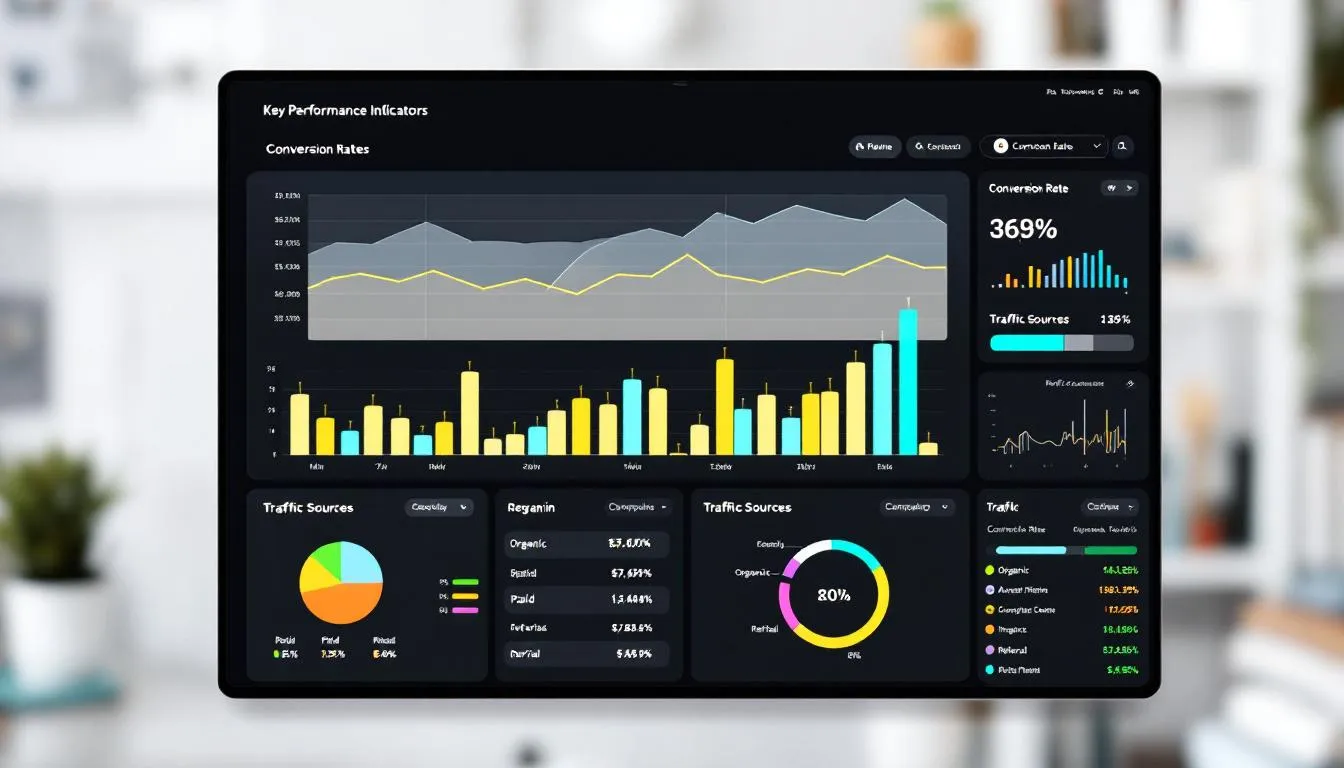How to Set Marketing Goals: Key Takeaways for your Marketing Strategy
- Sales-driven marketing goals must directly connect to revenue outcomes, not just vanity metrics like impressions or followers.
- Effective marketing goals follow the SMART framework while prioritising measurable impact on the sales pipeline and conversion rates.
- Focus on goals that shorten sales cycles, increase deal sizes, and improve lead quality rather than lead quantity.
- Align marketing and sales teams around shared revenue targets with specific attribution models to track contributions.n
- Use data-driven insights from CRM and marketing automation platforms to set realistic yet ambitious sales-impact goals.
Most marketing teams set goals that look impressive on paper but fail miserably at driving actual sales. While you’re celebrating your 50th birthday, you’re seeing a 50% increase in social media engagement, yet your sales team is struggling to hit quota with the same old leads that never convert. Let’s explore How to Set Marketing Goals.
The problem is that marketing doesn’t work when goals are completely disconnected from revenue generation. According to industry research, only 22% of businesses claim their marketing and sales goals are fully integrated and aligned. This disconnect costs companies millions in lost revenue opportunities.
In this comprehensive guide, you’ll discover a framework for creating revenue-focused objectives, specific goal examples that impact your bottom line, and practical strategies for measuring success through sales outcomes.
Why Most Marketing Goals Fail to Drive Sales
The marketing industry has trained professionals to chase metrics that make them feel productive, but don’t move the needle. This fundamental misalignment between marketing activities and sales outcomes creates a dangerous illusion of progress.
Most marketing teams focus on vanity metrics like social media followers, website traffic volume, or email open rates instead of qualified pipeline generation. While these metrics might indicate brand awareness or marketing effort, they don’t guarantee that your marketing strategy is actually contributing to revenue growth. A company can have 100,000 followers and still struggle to generate quality leads that convert into paying customers.
The lack of clear attribution between marketing activities and closed deals further compounds this problem. When marketing campaigns can’t be directly tied to revenue outcomes, it becomes impossible to determine which marketing efforts truly drive sales. This attribution gap makes it nearly impossible to optimise marketing spend or prove marketing’s effectiveness.
Misalignment between marketing and sales team objectives creates another critical failure point. Marketing teams might be measured on lead quantity, while sales teams focus on lead quality and conversion rates. This creates a system where marketing feels successful, generating hundreds of leads, while sales teams waste time pursuing unqualified prospects who never had real purchase intent.
Traditional brand awareness goals, while important for long-term market positioning, often fail to translate into immediate sales impact. Building brand recognition takes time and doesn’t always correlate with near-term revenue generation, especially for businesses that need to show quarterly growth and meet sales targets.
Well-Defined Goals: The SMART Framework for Sales-Driven Marketing Goals
The SMART criteria become exponentially more powerful when adapted specifically for sales-driven marketing objectives. Each element of the framework must be filtered through the lens of revenue impact to ensure your marketing goals actually drive sales.
Specific sales-driven goals go beyond generic objectives like “increase brand awareness” to define measurable sales outcomes. Instead of simply saying “generate more leads,” a specific goal would be “increase marketing-qualified leads that convert to customers by 25%.” This specificity compels you to consider the entire customer journey, from initial contact to closed deal, ensuring that your marketing activities effectively support the sales process.
Measurable components must focus on CRM data, conversion rates, and revenue attribution as key performance indicators. Traditional marketing metrics like impressions or clicks become secondary to metrics that directly correlate with sales performance. Your measurement system should track how marketing activities influence deal progression, sales cycle velocity, and ultimately closed revenue.
Achievable targets require basing goals on historical performance data and current market conditions rather than wishful thinking. Analyse your existing conversion rates, customer acquisition costs, and sales team capacity to set realistic yet ambitious targets. Consider factors like market share potential, competitive landscape, and available resources when determining what’s achievable within your timeframe.
Relevant goals must directly support sales team quotas and broader business objectives. Every marketing goal should answer the question” “How does thi” “elp us close more deals or increase deal siz”?” If a goal doesn’t connect to revenue generation, it shouldn’t be for sales-driven marketing teams.
Time-bound elements should align with sales cycles and fiscal periods rather than arbitrary calendar dates. Set quarterly milestones that align with your average sales cycle length and coordinate with the sales team’s forecasting periods. This alignment ensures marketing efforts support sales targets when they matter most for business growth.
7 Marketing Goals That Actually Increase Revenue
Increase Marketing-Qualified Lead to Sales-Qualified Lead Conversion Rate
Focus on improving lead quality rather than quantity by implementing sophisticated lead-scoring models based on demographic and behavioural data. Target specific improvements in how leads progress from marketing-qualified to sales-qualified status through better nurturing processes and more precise qualification criteria.
Implement lead-scoring models that consider factors such as company size, industry, budget authority, and engagement behaviour to identify prospects most likely to become customers. Track how leads that match your ideal customer profile characteristics convert at higher rates than generic prospects.
Example: Improve MQL to SQL conversion from 15% to 25% by Q4 2024 through enhanced lead scoring and personalised nurturing campaigns.
Reduce Customer Acquisition Cost While Maintaining Quality
Optimise marketing spend across digital channels to lower the cost per customer acquired without sacrificing lead quality or customer lifetime value. Focus marketing efforts on high-converting channels and audiences that deliver better ROI while maintaining or improving customer quality standards.
Track customer acquisition cost, payback periods, and lifetime value ratios to ensure that cost reduction doesn’t compromise long-term profitability—Analyse which marketing tactics generate customers with the highest lifetime value and shift budget allocation accordingly.
Example: Decrease CAC from $500 to $350 while maintaining average customer lifetime value above $2,500 through optimised channel mix and audience targeting.
Accelerate Sales Cycle Velocity Through Content Marketing
Create targeted content that addresses specific objections and questions at each stage of the buyer’s journey. Prospects move faster through your sales funnel. Measure how content consumption impacts deal progression speed and overall sales process efficiency.
Develop content assets that sales teams can use during prospect conversations to overcome common objections and demonstrate value. Track metrics like time from first touch to closed deal across different marketing channels to identify which content types most effectively accelerate the sales process.
Example: Reduce the average sales cycle from 90 days to 60 days by strategically developing content that addresses buyer concerns at each funnel stage.
Increase Average Deal Size Through Account-Based Marketing
Target high-value accounts with personalised marketing campaigns designed to influence larger deal sizes and expansion opportunities. Support your sales team with detailed account intelligence and engagement data that helps them pursue bigger opportunities with key prospects.
Implement account-based marketing strategies that focus on multiple stakeholders within target organisations to increase deal size and reduce sales cycle complexity. Track how ABM campaigns influence deal size expansion and upsell opportunities compared to traditional lead-generation approaches.
Example: Increase average deal size by 30% for ABM-targeted accounts through coordinated multi-stakeholder engagement campaigns.
Improve Sales Team Productivity Through Marketing Enablement
Provide sales teams with qualified leads, account intelligence, and sales tools that increase their conversion rates and quota attainment. Create sales enablement resources like battle cards, competitive intelligence, and objection-handling guides that help sales professionals close more deals.
Measure the impact of marketing enablement on sales team performance metrics like conversion rates, deal velocity, and overall quota attainment. Track how marketing-provided resources influence sales team productivity and effectiveness.
Example: Increase sales team quota attainment from 75% to 90% through improved lead qualification and comprehensive sales enablement programs.
Boost Customer Retention and Expansion Revenue
Develop marketing programs tailored to existing customer engagement, upselling, and cross-selling opportunities. Track customer health scores and identify expansion opportunities through behavioural data and engagement patterns.
Support customer success teams with targeted marketing campaigns that promote product adoption, feature utilisation, and upgrade opportunities. Focus on increasing revenue growth from existing customers rather than relying solely on new customer acquisition.
Example: Increase expansion revenue by 40% through targeted customer marketing campaigns and improved renewal processes.
Generate Pipeline Coverage for Sales Targets
Ensure marketing activities generate adequate pipeline coverage to support sales quotas, typically requiring 3-4x pipeline coverage depending on your conversion rates and sales velocity. Track pipeline generation by source and stage to ensure a consistent flow of qualified opportunities.
Align marketing investment and activities with sales capacity and territory needs to maintain proper pipeline coverage ratios. Monitor pipeline velocity and conversion rates at each stage to identify potential bottlenecks or optimisation opportunities.
Example: Generate $10M in qualified pipeline to support $3M sales quota through coordinated demand generation and lead nurturing programs.
Your Marketing Plan: How to Measure and Track Sales-Driven Marketing Goals
Essential Metrics and Key Performance Indicators
Marketing-influenced pipeline and revenue attribution percentages provide the clearest picture of marketing’s Track what percentage of closed deals included marketing touchpoints and how much revenue can be attributed to specific marketing campaigns or channels.
Lead-to-customer conversion rates by marketing channel and campaign reveal which marketing activities most effectively drive sales outcomes. Monitor these conversion rates over time to identify trends and optimisation opportunities that improve overall marketing performance.
Sales cycle acceleration and deal velocity improvements demonstrate how marketing activities help prospects move faster through your sales funnel. Measure average deal progression time and identify which marketing touchpoints correlate with faster sales cycles.
Customer acquisition cost and customer lifetime value ratios ensure that marketing efficiency improvements don’t compromise long-term profitability. Track these metrics across different customer segments and acquisition channels to optimise marketing spend allocation.
Setting up proper attribution models requires tracking customer touchpoints across multiple channels and interactions. Implement multi-touch attribution that assigns appropriate credit to various marketing activities throughout the customer journey, providing more accurate insights into marketing’s actions.
Technology Stack for Tracking
CRM integration with marketing automation platforms provides full-funnel visibility from initial prospect engagement through deal closure. Ensure your technology stack captures all customer interactions and provides seamless data flow between marketing and sales systems.
Revenue attribution tools like HubSpot Analytics, Salesforce Analytics, or specialised platforms like Bizible provide sophisticated tracking of marketing. These tools help identify which marketing campaigns and channels drive sales outcomes most effectively.
Marketing dashboards should display real-time impact on the sales pipeline, including metrics like pipeline coverage, conversion rates, and revenue attribution. Create dashboards that both marketing and sales teams can access to maintain transparency and alignment around shared goals.
Regular reporting cadence should align with sales team meetings and forecasting cycles to ensure marketing insights support sales planning and execution. Coordinate reporting schedules to provide relevant data when sales teams need it most for decision-making.
Aligning Marketing and Sales Teams Around Revenue Goals
Create shared service-level agreements between the marketing and sales teams that define lead quality standards, follow-up timeframes, and qualification criteria. These SLAs ensure both teams understand their responsibilities and maintain accountability for achieving shared revenue targets.
Establish joint revenue targets and accountability structures that incentivise collaboration rather than competition between marketing and sales departments. When both teams share responsibility for revenue outcomes, they’re more likely to work together effectively toward common business objectives.
Implement regular review meetings to discuss goal progress, market feedback, and necessary adjustments to marketing strategies or sales processes. These collaborative sessions help both teams stay aligned and responsive to changing market conditions or performance trends.
Use shared tools and dashboards that provide transparent performance tracking for both marketing and sales activities. When both teams can see the same data and metrics, it eliminates confusion and creates accountability for achieving shared revenue goals.
Develop joint compensation or incentive structures that tie marketing team rewards to sales outcomes and sales team success to marketing-generated opportunities. This alignment ensures both teams remain focused on activities that drive actual revenue rather than just departmental metrics.
Common Mistakes When Setting Sales-Driven Marketing Goals
Setting unrealistic targets without considering the sales team’s capacity and current market conditions leads to frustration and goal abandonment. Before setting ambitious marketing goals, evaluate whether your sales team can handle increased lead volume or if market conditions support aggressive growth targets.
Focusing solely on lead quantity without regard for lead quality and conversion rates creates a false sense of marketing success while overwhelming sales teams with unqualified prospects. Balance volume goals with quality metrics to ensure marketing efforts truly support sales effectiveness.
Ignoring sales cycle length when setting timeline expectations for results creates unrealistic pressure for immediate outcomes. Consider your average sales cycle when setting goal timelines, allowing sufficient time for marketing efforts to influence actual sales results.
Failing to account for attribution delays and multi-touch customer journeys can lead to premature goal adjustments or strategy changes. Remember that customers often interact with multiple marketing touchpoints before making purchase decisions, requiring patience and sophisticated tracking to measure true impact.
Not involving sales teams in the goal-setting process eliminates valuable feedback about lead quality, market conditions, and realistic growth expectations. Include sales team input when setting marketing goals to ensure objectives align with on-the-ground market realities.
FAQ
How long does it typically take to see results from sales-driven marketing goals?
Most B2B companies see initial pipeline impact within 3-6 months, but revenue results often take 6-12 months due to sales cycle length and attribution complexity. The timeline depends heavily on your industry’s cycle, deal size, and the sophistication of your tracking systems. Start measuring leading indicators like lead quality improvements and sales team feedback much earlier than final revenue outcomes. What’s the conversion rate of marketing-qualified leads to sales-qualified leads?
Industry benchmarks suggest 20-30% MQL to SQL conversion rates, but this varies significantly by industry, deal size, and lead scoring criteria. B2B technology companies often see higher conversion rates (25-35%) while consumer products might see lower rates (10-20%). Focus more on improving your own baseline conversion rate rather than comparing to industry averages, as lead qualification standards vary widely between organisations.
How do you handle attribution when customers have multiple touchpoints before purchasing?
Implement multi-touch attribution models that assign fractional credit to various marketing touchpoints throughout the customer journey. First-touch, last-touch, and U-shaped models are most common, with U-shaped attribution giving more credit to first and last interactions while still recognising middle-funnel activities. Choose an attribution model that reflects your actual sales process and customer behaviour patterns.
Should marketing goals be tied directly to sales quotas?
Marketing goals should align with sales quotas by ensuring appropriate pipeline coverage ratios, typically ranging from 3 to 4 times the sales target. This ratio can vary based on your conversion rates and sales velocity. However, marketing goals should focus on activities within marketing’s scope, such as lead generation and nurturing, rather than on final sales outcomes, which depend on the sales team’s execution. It’s essential to create complementary goals that support sales success without holding marketing accountable for factors beyond their control.
How often should sales-driven marketing goals be reviewed and adjusted?
Monthly reviews for tactical adjustments and quarterly reviews for strategic goal modifications work best, aligned with sales forecasting and planning cycles. Monthly check-ins allow for quick course corrections based on early performance data, while quarterly reviews provide enough time to see meaningful results and make informed strategic decisions. Avoid changing goals too frequently, as marketing activities often require time to show a measurable impact on sales outcomes.
Take your business to the next level with a Pixel Fish Website.
Check out some of our latest Website Design projects.
Further Information
How to create Recurring Revenue through Your Website
What does CRM stand for and why your business needs one
How to Build Multiple Email Lists for Your Business from your Website
6 Quick Tips on How to Choose a Web Designer
Understanding the Purpose of your Website: Key Elements for Success









